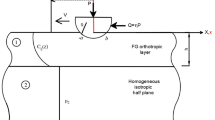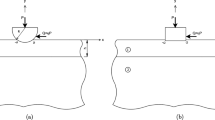Abstract
With the increasing research in the field of contact mechanics, different types of contact models have been investigated by many researchers by employing various complex material models. To ascertain the orthotropy effect and modeling parameters on a receding contact model, the double frictional receding contact problem for an orthotropic bilayer loaded by a cylindrical punch is taken into account in this study. Assuming plane strain sliding conditions, the governing equations are found analytically using Fourier integral transformation technique. Then, the resulting singular integral equations are solved numerically using an iterative method. The weight function describing the asymptotic behavior of the stresses are investigated in detail and powers of the stress singularities are provided. To control the trustworthiness and correctness of the analytical formulation and to compare the resulting stress distributions and contact boundaries, a numerically efficient finite element method was employed using augmented Lagrange contact algorithm. The aim of this paper is to investigate the orthotropy effect, modeling parameters and coefficients of friction on the surface and interface stresses, surface and interface contact boundaries, powers of stress singularities, weight function and to provide highly parametric benchmark results for tribological community in designing wear resistant systems.















Similar content being viewed by others
References
Hwu C, Fan CW (1998) Solving the punch problems by analogy with the interface crack problems. Int J Solids Struct 35(30):3945–3960
Shi D, Lin Y, Ovaert TC (2003) Indentation of an orthotropic half-space by a rigid ellipsoidal indenter. J Tribol 125(2):223
Swanson SR (2004) Hertzian contact of orthotropic materials. Int J Solids Struct 41(7):1945–1959
Willis JR (1966) Hertzian contact of anisotropic bodies. J Mech Phys Solids 14(3):163–176
Srinivas S, Rao AK (1970) Bending, vibration and buckling of simply supported thick orthotropic rectangular plates and laminates. Int J Solids Struct 6(11):1463–1481
Batra RC, Jiang W (2008) Analytical solution of the contact problem of a rigid indenter and an anisotropic linear elastic layer. Int J Solids Struct 45(22):5814–5830
Guler MA (2014) Closed-form solution of the two-dimensional sliding frictional contact problem for an orthotropic medium. Int J Mech Sci 87:72–88
Zhou YT, Kim TW (2014) Closed-form solutions for the contact problem of anisotropic materials indented by two collinear punches. Int J Mech Sci 89:332–343
Alinia Y, Hosseini-nasab M, Güler MA (2018) The sliding contact problem for an orthotropic coating bonded to an isotropic substrate. Eur J Mech A Solids 70:156–171
Yilmaz KB, Çömez Güler MA, Yildirim B (2019) Analytical and finite element solution of the sliding frictional contact problem for a homogeneous orthotropic coating-isotropic substrate system. ZAMM 99(3):e201800117
Keer LM, Mowry DB (1979) The stress field created by a circular sliding contact on transversely isotropic spheres. Int J Solids Struct 15(1):33–39
Kuo CH, Keer LM (1992) Contact stress analysis of a layered transversely isotropic half-space. J Tribol 114(2):253
Hanson MT (1992) The elastic field for spherical Hertzian contact including sliding friction for transverse isotropy. J Tribol 114(3):606
Ning X, Lovell M, Slaughter WS (2006) Asymptotic solutions for axisymmetric contact of a thin, transversely isotropic elastic layer. Wear 260(7):693–698
Liu H, Pan E (2018) Indentation of a flat-ended cylinder over a transversely isotropic and layered half-space with imperfect interfaces. Mech Mater 118:62–73
Binienda WK, Pindera MJ (1994) Frictionless contact of layered metal–matrix and polymer–matrix composite half planes. Compos Sci Technol 50(1):119–128
Comez I, Yilmaz KB (2019) Mechanics of frictional contact for an arbitrary oriented orthotropic material. ZAMM 99(3):e201800084
Dundurs J (1975) The mechanics of the contact between deformable bodies, 1st edn. Springer, Amsterdam
Dundurs J, Stippes M (1970) Role of elastic constants in certain contact problems. J Appl Mech 37:965–970
Keer LM, Dundurs J, Tsai KC (1972) Problems involving a receding contact between a layer and a half space. J Appl Mech 39(4):301–309
Gladwell GML (1976) On some unbonded contact problems in plane elasticity theory. J Appl Mech 43(2):263–267
Comez I, Birinci A, Erdol R (2004) Double receding contact problem for a rigid stamp and two elastic layers. Eur J Mech A Solids 23(2):301–309
El-Borgi S, Abdelmoula R, Keer L (2006) A receding contact plane problem between a functionally graded layer and a homogeneous substrate. Int J Solids Struct 43(3):658–674
Kahya V, Ozsahin TS, Birinci A, Erdol R (2007) A receding contact problem for an anisotropic elastic medium consisting of a layer and a half plane. Int J Solids Struct 44(17):5695–5710
Rhimi M, El-Borgi S, Saïd WB, Jemaa FB (2009) A receding contact axisymmetric problem between a functionally graded layer and a homogeneous substrate. Int J Solids Struct 46(20):3633–3642
Comez I (2010) Frictional contact problem for a rigid cylindrical stamp and an elastic layer resting on a half plane. Int J Solids Struct 47(7):1090–1097
El-Borgi S, Usman S, Guler MA (2014) A frictional receding contact plane problem between a functionally graded layer and a homogeneous substrate. Int J Solids Struct 51(25):4462–4476
Yan J, Li X (2015) Double receding contact plane problem between a functionally graded layer and an elastic layer. Eur J Mech A Solids 53:143–150
Parel K, Hills D (2016) Frictional receding contact analysis of a layer on a half-plane subjected to semi-infinite surface pressure. Int J Mech Sci 108–109:137–143
Adibelli H, Comez I, Erdol R (2013) Receding contact problem for a coated layer and a half-plane loaded by a rigid cylindrical stamp. Arch Mech 65(3):219–236
Comez I, El-Borgi S, Kahya V, Erdol R (2016) Receding contact problem for two-layer functionally graded media indented by a rigid punch. Acta Mech 227(9):2493–2504
Yan J, Mi C (2017) On the receding contact between an inhomogeneously coated elastic layer and a homogeneous half-plane. Mech Mater 112(Supplement C):18–27
El-Borgi S, Comez I (2017) A receding frictional contact problem between a graded layer and a homogeneous substrate pressed by a rigid punch. Mech Mater 114(Supplement C):201–214
McDevitt TW, Laursen TA (2000) A mortar-finite element formulation for frictional contact problems. Int J Numer Methods Eng 48(1):1525–1547
Li C, Zou Z, Duan Z (2000) Multiple isoparametric finite element method for nonhomogeneous media. Mech Res Commun 27(2):137–142
Kim JH, Paulino GH (2002) Isoparametric graded finite elements for nonhomogeneous isotropic and orthotropic materials. J Appl Mech 69(1):502–514
Dag S, Guler MA, Yildirim B, Ozatag AC (2009) Sliding frictional contact between a rigid punch and a laterally graded elastic medium. Int J Solids Struct 46:4038–4053
Guler MA, Gulver YF, Nart E (2012) Contact analysis of thin films bonded to graded coatings. Int J Mech Sci 55:50–64
Brezeanu LC (2014) Contact stresses: analysis by finite element method (FEM). In: Procedia technology, the 7th international conference interdisciplinarity in engineering (INTER-ENG 2013), vol 12, pp 401–410
Guler MA, Kucuksucu A, Yilmaz KB, Yildirim B (2017) On the analytical and finite element solution of plane contact problem of a rigid cylindrical punch sliding over a functionally graded orthotropic medium. Int J Mech Sci 120:12–29
Yilmaz KB, Comez I, Yildirim B, Güler MA, El-Borgi S (2018) Frictional receding contact problem for a graded bilayer system indented by a rigid punch. Int J Mech Sci 141:127–142
Yang Z, Deng X, Li Z (2019) Numerical modeling of dynamic frictional rolling contact with an explicit finite element method. Tribol Int 129:214–231
Comez I, Erdol R (2013) Frictional contact problem of a rigid stamp and an elastic layer bonded to a homogeneous substrate. Arch Appl Mech 83(1):15–24
Erdogan F, Gupta G (1972) On the numerical solution of singular integral equations. Q Appl Math 29:525–539
Author information
Authors and Affiliations
Corresponding author
Ethics declarations
Conflict of interest
The authors declare that they have no conflict of interest.
Additional information
Publisher's Note
Springer Nature remains neutral with regard to jurisdictional claims in published maps and institutional affiliations.
Appendices
Appendix 1
Expressions for \(C_{11}\), \(C_{13}\), \(C_{33}\) and \(C_{55}\) appearing in Eq. (5)
where
Appendix 2
Expressions for \({{k}_{11}}({{x}_{1}},{{t}_{1}})\), \({{k}_{12}}({{x}_{1}},{{t}_{2}})\), \({{k}_{21}}({{x}_{2}},{{t}_{1}})\), \({{k}_{22}}({{x}_{2}},{{t}_{2}})\) appearing in Eq. (17),
where
where
Expressions for \(a_{j}\) and \(b_{i}\) appearing in Eq. 18,
Rights and permissions
About this article
Cite this article
Yildirim, B., Yilmaz, K.B., Comez, I. et al. Double frictional receding contact problem for an orthotropic layer loaded by normal and tangential forces. Meccanica 54, 2183–2206 (2019). https://doi.org/10.1007/s11012-019-01058-4
Received:
Accepted:
Published:
Issue Date:
DOI: https://doi.org/10.1007/s11012-019-01058-4




